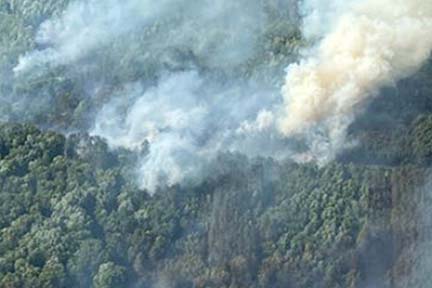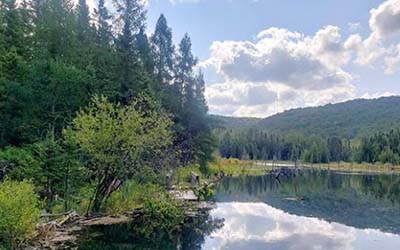| Here are just a few of this week’s stories from the Michigan Department of Natural Resources, leading into the July Fourth holiday weekend:
See other news releases, Showcasing the DNR stories, photos and other resources at Michigan.gov/DNRPressRoom.
PHOTO FOLDER: Larger, higher-res versions of the images used in this email are available in this folder.
 Michiganders know our weather can change on a dime. That’s true when it comes to fire-related risk, too, especially now with drought conditions in much of the state and air quality being dramatically affected by smoke from Canada wildfires. We want everyone to enjoy the outdoors, and arming yourself with information is key: Michiganders know our weather can change on a dime. That’s true when it comes to fire-related risk, too, especially now with drought conditions in much of the state and air quality being dramatically affected by smoke from Canada wildfires. We want everyone to enjoy the outdoors, and arming yourself with information is key:
 As you make Independence Day plans, prepare for fun and safety, too. Care with campfires and fireworks is critical, as Michigan continues its run of unusually dry weather that puts fields and forests at risk for wildfire. As you make Independence Day plans, prepare for fun and safety, too. Care with campfires and fireworks is critical, as Michigan continues its run of unusually dry weather that puts fields and forests at risk for wildfire.
If you choose to use fireworks over the July Fourth holiday, the following tips can help avoid injuries or sparking a wildfire.
Do:
- Supervise kids with fireworks and sparklers. Keep fireworks away from your face.
- Use fireworks only on a flat paved or gravel surface. Spray down the area with water before you start and when you’re done.
- Toss used fireworks and sparklers into a bucket of water.
- Keep a water source ready to spray embers from fireworks.
Don’t:
- Try to reignite “dud” fireworks that don’t go off. Wait 15 minutes, then place them in a bucket of water.
- Launch fireworks into forests or fields where dry grass or leaves could ignite.
Aerial fireworks such as Roman candles and bottle rockets are not allowed at Michigan state parks, harbors or trails. Smaller novelty fireworks such as fountains, sparklers and ground spinners are permitted in campgrounds.
“Fun, spark-free alternatives to fireworks include ribbon dancers, paper confetti poppers, glow-in-the-dark bubbles and glow sticks,” said DNR Parks and Recreation Division Chief Ron Olson.
Sky lanterns are not allowed on DNR-managed public lands. They leave wires that can entangle wildlife and foul equipment, and they have the potential to start wildfires.
So far this season, DNR firefighters have responded to more than 230 wildfires. Get wildfire prevention tips at Michigan.gov/PreventWildfires and check to see if it’s safe to burn brush and leaves at Michigan.gov/BurnPermit.
Questions? Contact Paul Rogers at 616-260-8406. |
 Conservation officers will have an increased presence on Michigan waterways July 1-3 as part of Operation Dry Water, a national law enforcement campaign to promote sober boating. Conservation officers will have an increased presence on Michigan waterways July 1-3 as part of Operation Dry Water, a national law enforcement campaign to promote sober boating.
There’s good reason for the effort. According to the most recent U.S. Coast Guard report, alcohol remains the primary contributing factor in recreational boater deaths.
Alcohol impairs a boater’s judgment, balance, vision and reaction time, and can increase fatigue and susceptibility to the effects of cold-water immersion. Sun, wind, noise, vibration and motion – elements common to the boating environment – intensify the side effects of alcohol, drugs and some medications.
Nationally, law enforcement officers contacted 350,472 boaters, made 794 boating under the influence arrests, and issued 45,067 citations and warnings for safety violations during last year’s Operation Dry Water campaign.
The DNR encourages boaters to ride only with a sober operator who has a valid boater safety education certificate. Learn more about boating safety or sign up for a boater safety course at Michigan.gov/RecreationalSafety.
Questions? Contact Katie Gervasi at 517-290-0679. |

Ahoy, boaters! Ready for Michigan’s 10th annual Aquatic Invasive Species Awareness Week?
This year it runs July 2-8 and features outreach events at more than 50 sites across the state. Michigan’s Invasive Species Program partners and volunteers will be reminding boaters to “clean, drain, dry” their boats and trailers before getting back on the road.
Boaters and anglers need to know that state law requires removal of plants and debris from watercraft and trailers; removal of drain plugs; and draining of bilges, ballast tanks and live wells before any watercraft is transported. Remembering to “clean, drain, dry” also helps prevent the spread of invasives like starry stonewort and zebra and quagga mussels.
Michigan’s AIS Awareness Week events support the Great Lakes AIS Landing Blitz, spreading the word about aquatic invasive species prevention throughout the Great Lakes states and Canadian provinces. It’s sponsored by the Michigan Department of Environment, Great Lakes, and Energy’s Water Resources Division in partnership with the departments of Natural Resources and Agriculture and Rural Development, federal agencies and private and nonprofit organizations.
Get involved with AIS Awareness Week and the AIS Landing Blitz and learn about preventing the spread of invasive species at Michigan.gov/Invasives.
Questions? Contact Joanne Foreman at ForemanJ@Michigan.gov.
 To boost awareness of changing conditions and save lives, there’s a new addition to the Great Lakes beach flag warning system. If you see double red flags, you are not allowed to enter the water from the beach. To boost awareness of changing conditions and save lives, there’s a new addition to the Great Lakes beach flag warning system. If you see double red flags, you are not allowed to enter the water from the beach.
A DNR land use order now makes it illegal to enter the water when there is risk to human health and safety. Risks can include hazardous waves and/or dangerous water conditions, active rescue or recovery efforts, and environmental hazards. This order does not apply to surfers using wind-powered or self-propelled wave-riding boards.
More ways to stay safe
Keep these other cautions in mind when enjoying time in and around the Great Lakes:
- There are no beach guards at state parks. Never swim alone and always keep close watch of children and bring U.S. Coast Guard-approved life jackets, especially for new and inexperienced swimmers.
- Water currents near piers, breakwalls and outlets of rivers can be extremely hazardous.
- Visitors in areas without designated swim beaches should use extreme caution because they will not have the benefit of the beach flag warning system or the visual cautions of buoys that mark water depth and obstacles.
- When water access is permitted, be prepared for widely varying water temps; some parts of the Great Lakes are still hovering around 50 to 60 degrees Fahrenheit.
- Before leaving home for any beach outing, check local weather reports and lake conditions and learn about the types of Great Lakes currents and how to escape them.
Visit Michigan.gov/BeachSafety for tips and information on safely visiting the Great Lakes, including state-designated swim beach locations, the beach flag warning system, Great Lakes currents (and how to escape them) and more.
Questions? Contact Pat Whalen at 269-838-1196. |
 A long holiday weekend means many people will be enjoying one of the fastest-growing recreation activities in Michigan – off-road vehicle riding. If you’ll be on a quad, side-by-side, dirt bike or other type of ORV, the DNR wants everyone to Ride Right to ensure you ride again. A long holiday weekend means many people will be enjoying one of the fastest-growing recreation activities in Michigan – off-road vehicle riding. If you’ll be on a quad, side-by-side, dirt bike or other type of ORV, the DNR wants everyone to Ride Right to ensure you ride again.
Speed, drugs and alcohol, and reckless operation are leading causes of ORV accidents.
“Conservation officers are seeing an increase in alcohol and marijuana use, particularly on side-by-sides,” said the DNR’s Cpl. Mike Hearn. “Alcohol and marijuana laws are the same for ORVs as they are for street vehicles – there’s zero tolerance.”
If you are the first rider (acting as leader) of an ORV group, you can help prevent reckless operation by leading at a safe speed for all rider abilities, conditions and equipment. Also be cautious of dust clouds, especially during dry weather conditions such as those Michigan is now experiencing. Dust clouds can impair your ability to see nearby riders, trees and other objects, making it challenging to determine a safe stopping distance. |
 Keep these important ORV safety tips in mind: Keep these important ORV safety tips in mind:
- Ride at a safe speed based on your abilities and the machine’s capabilities.
- Know the trail conditions.
- Ride sober; open alcohol is not allowed on side-by-sides or any other ORV.
- Ride on the right side of the trail.
- Wear a helmet and other appropriate safety gear, such as eye protection, gloves, footwear and chest protectors.
- Ride with your lights on to increase your visibility to others.
- Always supervise ORV operators who are under the age of 16 (it’s the law).
- Complete an approved ORV safety course.
- Refer to manufacturer guidelines for passenger limits.
- Stay on the trail and watch where you park. A hot muffler or engine can ignite dry leaves or grass, so keep machines and trailer chains away from potential fire fuel.
Read more about ORV safety at Michigan.gov/RideRight. For more on where to ride and ORV laws in Michigan, go to Michigan.gov/ORVInfo.
Questions? Contact Cpl. Mike Hearn at HearnM@Michigan.gov. |
|









